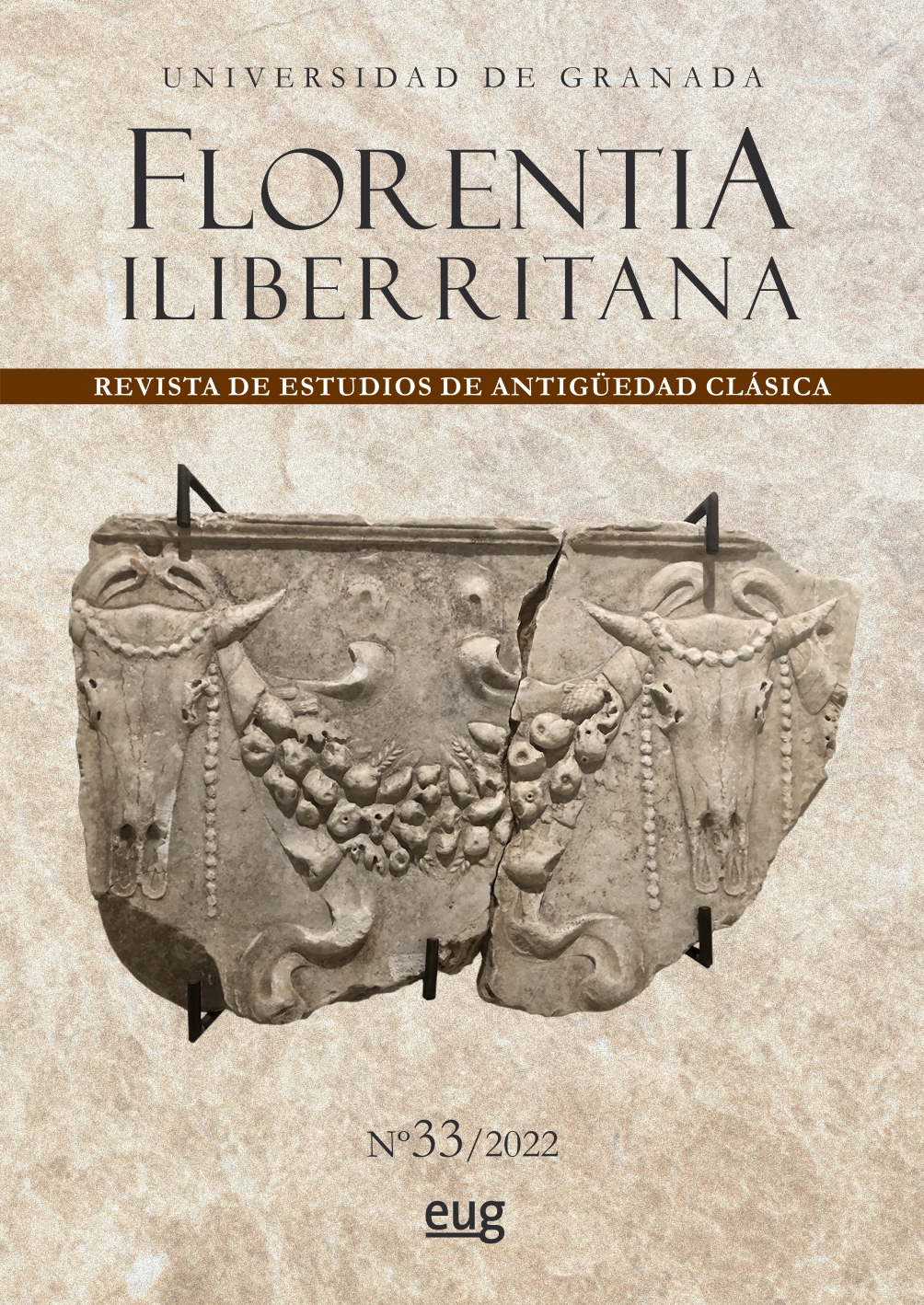Las aptitudes del embrión. Propuestas neoplatónicas del tratado Ad Gaurum
DOI:
https://doi.org/10.30827/floril.v33i.26088Palabras clave:
Porfirio, Ad Gaurum, embriología, aptitud, neoplatonismoResumen
Para explicar de qué modo el embrión recibe el alma, el autor del tratado epistolar Ad Gaurum, probablemente Porfirio, aplica a la noción de “aptitud” (ἐπιτηδειότης) un nuevo enfoque que, desde la metafísica neoplatónica, redefine la noción aristotélica de “en potencia”. En el momento del parto, se implanta en el embrión que es apto para recibirla un alma animal, que le dota de sensación e impulso y que le permite un movimiento local.
Descargas
Citas
AUBRY, G. (2006), Dieu sans la puissance: Dunamis et energeia chez Aristote et chez Plotin. Paris, Librairie philosophique J. Vrin.
AUBRY, G. (2008), «Capacité et convenance: la notion d’epitêdeiotês dans la théorie porphyrienne de l’embryon», in L. Brisson, M.-H. Congourdeau, J.-L. Solère (eds.), L'embryon. Formation et animation. Antiquité grecque et latine, tradition hébraïque, chrétienne, et islamique. Paris, Librairie Philosophique J. Vrin: 139-156.
AUBRY, G. (2012), «La doctrine aristotélicienne de l’embryon et sa réinterprétation par Porphyre», in L. Brisson, G. Aubry, M.-H. Congourdeau, F. Hudry (eds.), Porphyre. Sur la manière dont l’embryon reçoit l’âme. Paris, Librairie Philosophique J. Vrin: 47-67.
BOUFFARTIGUE, J., PATILLON, J.M. & SEGONDS, A.P. (1977-1995), Porphyre, De l'abstinence, 3 vols. Paris, Les Belles-Lettres.
BRISSON, L. (ed.) (2005), Porphyre. Sentences, I-II. Paris, Librairie Philosophique J. Vrin.
BRISSON, L., AUBRY, G., CONGOURDEAU, M.-H. & HUDRY, F. (eds.) (2012), Porphyre. Sur la manière dont l’embryon reçoit l’âme. Paris, Librairie Philosophique J. Vrin.
BRISSON, L., CONGOURDEAU, M.-H. & SOLÈRE, J.-L. (eds.) (2008). L'embryon. Formation et animation. Antiquité grecque et latine, tradition hébraïque, chrétienne, et islamique. Paris, Librairie Philosophique J. Vrin.
BRUNS, I. (1887-1892), Alexandri Aphrodisiensis praeter commentaria scripta minora, I-II. Berolini, Georgii Reimeri.
BURNET, J. (1901-1907), Platonis Opera, II-V. Oxford, University Press.
COOPER, J. M. (1988), «Metaphysics in Aristotle’s Embryology», Proceedings of the Cambridge Philological Society 214: 14-41.
DES PLACES, E. (1982), Porphyre. Vie de Pythagore. Lettre à Marcella. Paris, Les Belles-Lettres.
DEUSE, W. (1983), Untersuchungen zur mittelplatonischen und neuplatonischen Seelenlehre. Mainz/Wiesbaden, Franz Steiner.
DORANDI, T. (2008), «Pour une histoire du texte du traité Ad Gaurum attribué à Galien», in L. Brisson, M.-H. Congourdeau, J.-L. Solère (eds.), L'embryon. Formation et animation. Antiquité grecque et latine, tradition hébraïque, chrétienne, et islamique. Paris, Librairie Philosophique J. Vrin: 123-137.
DÖRRIE, H. (1959), Porphyrios’ “Symmikta Zetemata”. Ihre Stellung in System und Geschichte des Neuplatonismus nebst einem Kommentar zu den Fragmenten. München, C. H. Beck.
HENRY, P. & SCHWYZER, H.-R. (1964-1982), Plotini Opera, I-III. Oxford, University Press.
JOLY, R. (1970), Hippocrate. Oeuvres completes, XI, De la génération; De la nature de l'enfant; Des maladies IV; Du foetus de huit mois. Paris, Les Belles-Lettres.
KALBFLEISCH K. (1895), Die neuplatonische fälschlich dem Galen zugeschriebene Schrift πρòς Γαύρov περì τοῦ πῶς ἐμψυχοῦται τὰ ἔμβρυα. Berlin, Königliche Akademie der Wissenschaften.
LOUIS P. (1961), Aristote. De la génération des animaux. Paris, Les Belles-Lettres.
MENN, S. (2002), «Aristotle’s Definition of Soul and the Programme of the De Anima», Oxford Studies in Ancient Philosophy 22: 83-139.
MINIO-PALUELLO, L. (1949), Aristotelis Categoriae et Liber de Interpretatione. Oxford, Clarendon Press.
PÉPIN, J. (1999), «Pourquoi l’âme automotrice aurait–elle besoin d’un véhicule?», in J. J. Cleary (ed.), Traditions of Platonism. Essays in Honour of John Dillon. Aldershot, Ashgate Publishing: 293-305.
RODRÍGUEZ ADRADOS, F. & GANGUTIA, E. (eds.) (1980-2019), Diccionario Griego-Español (DGE), I-VII. Madrid, CSIC.
ROSS, W. D. (1936), Aristotle’s Physics. A Revised Text with Introduction and Commentary. Oxford, Clarendon Press.
ROSS, W. D. (1961), Aristotle. De Anima. Edited, with Introduction and Commentary. Oxford, Clarendon Press.
SLINGS, S. R. (2003), Platonis Rempublicam. Oxford, Clarendon Press.
SMITH, A. (1993), Porphyrii Philosophi fragmenta. Stuttgart/Leipzig, Teubner.
TODD, R. B. (1972), «Epitedeiotes in Philosophical Literature: Towards an Analysis», Acta Classica 15: 25-35.
WACHSMUTH, C. & HENSE, O. (1884-1912), Ioannis Stobaei Anthologium, 5 vols. Berlin, Apud Weidmannos.
WILBERDING, J. (2011), Porphyry. To Gaurus On How Embryos are Ensouled and On What is in Our Power. London, Bristol Classical Press.
WILBERDING, J. (2015a), «Neoplatonists on the Causes of Vegetative Life», in A. Marmodoro & B. Prince (eds.), Causation and Creation in Late Antiquity. Cambridge, University Press: 171-185.
WILBERDING, J. (2015b), «The Revolutionary Embryology of the Neoplatonists», Oxford Studies in Ancient Philosophy 49: 321-361.
WILBERDING, J. (207b), Forms, Souls, and Embryos. Neoplatonists on Human Reproduction, New York, Routledge.
WILBERDING, J. (2020), «The World Soul in the Embryological Theories of Porphyry and Plotinus”, in C. Helmig (ed.), World Soul-Anima Mundi: On the Origins and Fortunes of a Fundamental Idea. Berlin/Boston, De Gruyter: 269-288.
ZAMBON, M. (2002), Porphyre et le Moyen-Platonisme, Paris, Vrin.
ZAMORA CALVO, J. M. (2015a), «La fragua del alma: Crítica de Porfirio a la embriología estoica», Cuadernos de filosofía 64: 47-59.
ZAMORA CALVO, J. M. (2015b), «La embriología estoica», Azafea: Revista de Filosofía 17: 51-73.
















